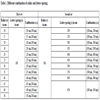- Home
- About Journals
-
Information for Authors/ReviewersEditorial Policies
Publication Fee
Publication Cycle - Process Flowchart
Online Manuscript Submission and Tracking System
Publishing Ethics and Rectitude
Authorship
Author Benefits
Reviewer Guidelines
Guest Editor Guidelines
Peer Review Workflow
Quick Track Option
Copyediting Services
Bentham Open Membership
Bentham Open Advisory Board
Archiving Policies
Fabricating and Stating False Information
Post Publication Discussions and Corrections
Editorial Management
Advertise With Us
Funding Agencies
Rate List
Kudos
General FAQs
Special Fee Waivers and Discounts
- Contact
- Help
- About Us
- Search

The Open Electrical & Electronic Engineering Journal
(Discontinued)
ISSN: 1874-1290 ― Volume 13, 2019
Simulation Studies on Semiconductor Photonic Crystal Using Photonic Bandgap Analysis: A Realization of Optical Mirror
C. Nayak1, P. Sarkar2, G. Palai3, *
Abstract
In this research, we attempt to envisage the mirror application using semiconductor photonic crystal with the help of photonic bandgap analysis. The photonic bandgap of photonic crystal structure is simulated using plane wave expansion method, where photonic crystal is realized by 2D triangular photonic crystal structure with gallium arsenide as background material having periodic air holes. Simulation result revealed that both lattice spacing of crystal structure and radius of air holes play vital role in realizing optical mirror. It is observed that photonic band gap of the above structure is found, if radius of air hole varies from 16 nm to 50 nm for lattice constant of 100 nm . It is also seen that photonic band gap is found if lattice spacing varies from 200 nm to 650 nm for radius of air hole of 100 nm.
Article Information
Identifiers and Pagination:
Year: 2016Volume: 10
First Page: 150
Last Page: 155
Publisher Id: TOEEJ-10-150
DOI: 10.2174/1874129001610010150
Article History:
Received Date: 21/07/2016Revision Received Date: 26/08/2016
Acceptance Date: 26/08/2016
Electronic publication date: 30/11/2016
Collection year: 2016
open-access license: This is an open access article licensed under the terms of the Creative Commons Attribution-Non-Commercial 4.0 International Public License (CC BY-NC 4.0) (https://creativecommons.org/licenses/by-nc/4.0/legalcode), which permits unrestricted, non-commercial use, distribution and reproduction in any medium, provided the work is properly cited.
* Address correspondence to this author at the Gandhi Institute for Technological Advancement (GITA), Janla, Bhubaneswar, PIN-752054, India; Tel: +91 9439045946; E-mail:gpalai28@gmail.com
| Open Peer Review Details | |||
|---|---|---|---|
| Manuscript submitted on 21-07-2016 |
Original Manuscript | Simulation Studies on Semiconductor Photonic Crystal Using Photonic Bandgap Analysis: A Realization of Optical Mirror | |
1. INTRODUCTION
The parameter photonic bandgap of artificial optical materials has been playing an important role to discussing various properties of photonic materials. Photonic bandgap materials realize the periodic structure in one, two or three dimension that forbids light propagation at certain range of frequencies or wavelengths [1J. Joannopoulos, S.G. Johnson, J. Winn, and R.D. Meade, Photonic Crystals: Molding the Flow of Light., University Press: Princeton, 1995.]. Due to these potential properties, various optical communication and sensing devices are being recently incorporated using photonic crystal waveguides [2G. Palai, "Measurement of impurity concentration in chalcogenide glasses using optical principle", Optik-International Journal for Light and Electron Optics, vol. 125, no. 19, pp. 5794-5799, 2014.
[http://dx.doi.org/10.1016/j.ijleo.2014.07.004] -7G. Palai, S.K. Tripathy, N. Muduli, S.K. Patnaik, and D. Patnaik, "A novel method to measure the strength of CygelTM by using two dimensional photonic crystal structures", AIP Conference Proceedings, vol. 1461, pp. 383-386, 2012.
[http://dx.doi.org/10.1063/1.4736926] ]. We in this paper attempt to realize an optical mirror using semiconductor photonic crystal, where photonic crystal structure is realized by 2D triangular photonic crystal structure having gallium arsenide as background material with periodic air holes. The said triangular crystal structure is shown in Fig. (1 ).
).
Fig. (1 ) represents two dimensional triangular crystal structure with periodic air holes. Fig. (1
) represents two dimensional triangular crystal structure with periodic air holes. Fig. (1 ) shows light having a particular ranges, of frequency or wavelength incident on gallium arsenide crystal structure. Out of these range light having a particular wavelength or a range of wavelengths cannot propagate through the same structure. This indicates the same range of wavelengths will be completely reflected from it. The reflected beam from such photonic crystal structure is referre as photonic bandgap. Though optical mirror does not directly depend on photonic band gap, the optical properties control the efficiency of optical mirror because a mirror is an object that reflects light. This optical phenomenon (reflection) is a key factor to realize a good mirror. Since photonic bandgap is represented as reflect light by a periodic object, the efficiency of optical mirror depends on the photonic bandgap. As far as photonic bandgap is concerned it depends on structure and configuration of the same photonic crystal structure. As far as structure is concerned, here we deal with 2D triangular structure with gallium arsenide as background material. Similarly, As far as the configuration is concerned, radius of air hole as well as lattice spacing plays an important role in obtaining photonic bandgap of aforementioned structure. So to realize such configuration, here we have chosen two set of data for radius (r) and lattice spacing (a), for example; firstly range of radius of air hole is taken as 16 nm to 49 nm, where lattice spacing is taken as 100 nm. Secondly the range of lattice spacing is taken of 200 nm as 650 nm, where radius of air hole is taken as 100 nm. So that different combination of both radius and lattice spacing are realized. The set of combinations of radius and lattice spacing are shown in Table 1.
) shows light having a particular ranges, of frequency or wavelength incident on gallium arsenide crystal structure. Out of these range light having a particular wavelength or a range of wavelengths cannot propagate through the same structure. This indicates the same range of wavelengths will be completely reflected from it. The reflected beam from such photonic crystal structure is referre as photonic bandgap. Though optical mirror does not directly depend on photonic band gap, the optical properties control the efficiency of optical mirror because a mirror is an object that reflects light. This optical phenomenon (reflection) is a key factor to realize a good mirror. Since photonic bandgap is represented as reflect light by a periodic object, the efficiency of optical mirror depends on the photonic bandgap. As far as photonic bandgap is concerned it depends on structure and configuration of the same photonic crystal structure. As far as structure is concerned, here we deal with 2D triangular structure with gallium arsenide as background material. Similarly, As far as the configuration is concerned, radius of air hole as well as lattice spacing plays an important role in obtaining photonic bandgap of aforementioned structure. So to realize such configuration, here we have chosen two set of data for radius (r) and lattice spacing (a), for example; firstly range of radius of air hole is taken as 16 nm to 49 nm, where lattice spacing is taken as 100 nm. Secondly the range of lattice spacing is taken of 200 nm as 650 nm, where radius of air hole is taken as 100 nm. So that different combination of both radius and lattice spacing are realized. The set of combinations of radius and lattice spacing are shown in Table 1.
 |
Fig. (1) 2D triangular photonic crystal structure with gallium arsenide as background material. |
The reason for choosing such radius and lattice spacing is that the absorption loss of gallium arsenide semiconductor crystal is zero at these dimensions [8F. Schubert, Materials-Refractive-index-and-extinction-coefficient, 2004. Available from: http://www.rpi.edu/~schubert/Educational- resources/Materials-Refractiveindex-and-extinction-coefficient.pdf]. As far as literature survey on optical mirror is concerned, a lot of similar type of research works deal with the same [9V. Lousse, W. Suh, O. Kilic, S. Kim, O. Solgaard, and S. Fan, "Angular and polarization properties of a photonic crystal slab mirror", Optics Express, vol. 12, no. 8, pp. 1575-1582, 2004.
[http://dx.doi.org/10.1364/OPEX.12.001575] [PMID: 19474983] -12L. Orsila, "Monolithic fiber mirror and photonic crystal technology for high repetition rate all-fiber soliton lasers", IEEE Photonics Technology Letters, vol. 19, no. 24, pp. 2009-2011, 2007.
[http://dx.doi.org/10.1109/LPT.2007.909625] ]. In reference [9V. Lousse, W. Suh, O. Kilic, S. Kim, O. Solgaard, and S. Fan, "Angular and polarization properties of a photonic crystal slab mirror", Optics Express, vol. 12, no. 8, pp. 1575-1582, 2004.
[http://dx.doi.org/10.1364/OPEX.12.001575] [PMID: 19474983] ] authors discuss the construction of optical mirror using photonic crystal slab. Similarly, in reference [10L. Ferrier, S. Boutami, and F. Mandorlo, "Vertical microcavities based on photonic crystal mirrors for III-V/Si integrated microlasers", In: Proceedings of Spie - The International Society for Optical Engineering, France, 2008.
[http://dx.doi.org/10.1117/12.781328] ], photonic crystal mirror is investigated using III-V/Si integrated devices. Mini stop band photonic crystal mirror is explored using GaAs based quantum dot laser in reference [11S.A. Moore, L. OFaolain, T.P. White, and T.F. Krauss, "Photonic crystal laser with mode selective mirrors", Optics Express, vol. 16, no. 2, pp. 1365-1370, 2008.
[http://dx.doi.org/10.1364/OE.16.001365] [PMID: 18542208] ]. Also in reference [12L. Orsila, "Monolithic fiber mirror and photonic crystal technology for high repetition rate all-fiber soliton lasers", IEEE Photonics Technology Letters, vol. 19, no. 24, pp. 2009-2011, 2007.
[http://dx.doi.org/10.1109/LPT.2007.909625] ] a dichroic mirror is realized using by the combination of ZrO and SiO2. Though these references provide viable result to realize optical mirror, but the structures are complex. To avoid this complexity, here we deal with a simple 2D triangular GaAs photonic crystal structure with periodic air holes, which delivers excellent result to envisage optical mirror. Using data from Table 1 and employing plane wave expansion method, simulation for photonic bandgap of 2D triangular photonic crystal structure is made, which is discussed in next section.
2. SIMULATION RESULT AND DISCUSSION
Photonic bandgap is a key parameter of photonic crystal structure to envisage mirror application. In this case, plane wave expansion (PWE) method is used to make simulation for photonic bandgap of 2D dimensional photonic crystal structures [13I.A. Sukhoivanov IV, Guryev, ‘Physics and Practical Modeling: Photonic Crystals., Springer: Heidelberg, 2009.
[http://dx.doi.org/10.1007/978-3-642-02646-1] ]. Here, simulation is made for finite area of proposed photonic crystal structure which contains six columns of air holes on GaAs substrate material. Photonic bandgap depends on structure parameters such as lattice spacing, radius of air holes, number of air holes including structure and configuration of crystal. In this case, we have chosen different combination of radius and lattice spacing, which is mentioned in the previous section. Using data from Table 1, (different combination of radius and lattice spacing), simulation is done for photonic bandgap of photonic crystal structure using plane wave expansion method. The simulation results for (100 nm, 200 nm) and (100 nm, 300 nm) of (r,a) are shown in Figs. (2a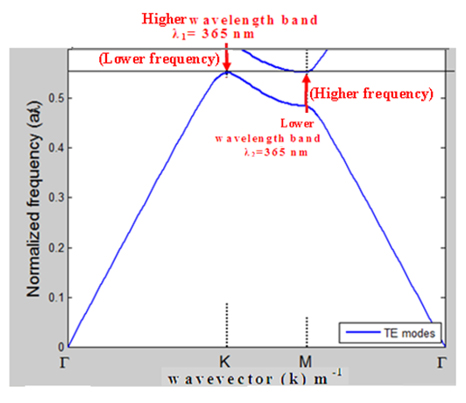 and 2b
and 2b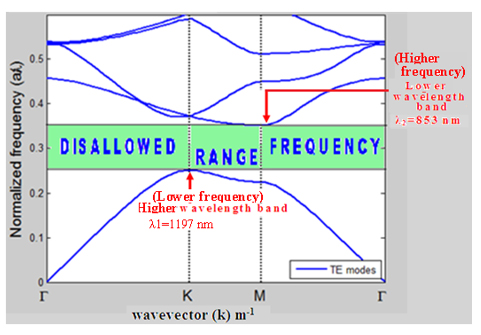 ) respectively.
) respectively.
 |
Fig. (2a) Simulation graph for photonic bandgap of 2D photonic crystal structure having radius of air hole, 100 nm and lattice spacing of 200 nm. |
 |
Fig. (2b) Simulation graph for photonic bandgap of 2D PCs having radius of air hole, 100 nm and lattice spacing of 300 nm. |
Simulation for other combination, such as (16 nm,100 nm), (17nm,100 nm), (18 nm,100 nm), (20 nm,100 nm), (25 nm,100 nm), (30 nm,100 nm), (35 nm,100 nm), (40 nm,100 nm), (45 nm,100 nm), (48 nm,100 nm), (49 nm,100 nm), (50 nm,100 nm), (100 nm, 250 nm), (100 nm, 350 nm), (100 nm, 400 nm), (100 nm, 450 nm), (100 nm, 500 nm), (100 nm, 550 nm), (100 nm, 600 nm) and (100 nm, 650 nm) of radius and lattice spacing are done but not shown here. Fig. (2a ) represents the dispersion diagram (photonic bandgap) of 2D photonic crystal structure with gallium arsenide as background material having lattice constant of 200 nm and radius of air holes, 100 nm. Similarly, Fig. (2b
) represents the dispersion diagram (photonic bandgap) of 2D photonic crystal structure with gallium arsenide as background material having lattice constant of 200 nm and radius of air holes, 100 nm. Similarly, Fig. (2b ) represents the dispersion diagram (photonic bandgap) of 2D photonic crystal structure with gallium arsenide as background materials having lattice constant of 300 nm and radius of air holes, 100 nm. From these figures, it is seen that normalized frequency (a/λ) is taken along vertical axis with respect to wave vector (K in m-1) along horizontal axis. Here, the difference between higher and lower band of normalized frequency is shown in these diagrams. This difference indicates that the range of normalized frequencies cannot pass through the same structure or these ranges of electromagnetic waves are completely reflected from such structures. Then, the wavelength range corresponding to each forbidden normalized frequency is computed. These wavelength ranges of electromagnetic wave will be reflected from such photonic crystal structure. Since reflected beam or light is nothing but the amount of photonic bandgap of photonic crystal structure, photonic band gap corresponding to each dispersion curve have been computed for the same. We know that photonic band gap is determined by taking difference between bottom of the higher band to the top of the lower band. Using above concept, it is seen from Fig. (2a
) represents the dispersion diagram (photonic bandgap) of 2D photonic crystal structure with gallium arsenide as background materials having lattice constant of 300 nm and radius of air holes, 100 nm. From these figures, it is seen that normalized frequency (a/λ) is taken along vertical axis with respect to wave vector (K in m-1) along horizontal axis. Here, the difference between higher and lower band of normalized frequency is shown in these diagrams. This difference indicates that the range of normalized frequencies cannot pass through the same structure or these ranges of electromagnetic waves are completely reflected from such structures. Then, the wavelength range corresponding to each forbidden normalized frequency is computed. These wavelength ranges of electromagnetic wave will be reflected from such photonic crystal structure. Since reflected beam or light is nothing but the amount of photonic bandgap of photonic crystal structure, photonic band gap corresponding to each dispersion curve have been computed for the same. We know that photonic band gap is determined by taking difference between bottom of the higher band to the top of the lower band. Using above concept, it is seen from Fig. (2a ) that higher and lower bands of normalized frequency are overlapped. This indicates that there is no band gap exists between them (upper and lower band). It is understood that no photonic band gap is available in the same graph. And also it is inferred that no light will be reflected, if gallium arsenide photonic crystal structure will have 200 nm of lattice constant and 100 nm of radius of air holes. So it is concluded that such dimensions of the same structure is not suitable for mirror application. However, bandgap is clearly found in Fig. (2b
) that higher and lower bands of normalized frequency are overlapped. This indicates that there is no band gap exists between them (upper and lower band). It is understood that no photonic band gap is available in the same graph. And also it is inferred that no light will be reflected, if gallium arsenide photonic crystal structure will have 200 nm of lattice constant and 100 nm of radius of air holes. So it is concluded that such dimensions of the same structure is not suitable for mirror application. However, bandgap is clearly found in Fig. (2b ). In this figure lower and higher, a/λ are shown by arrow mark. Apart from this the wavelength corresponding to each normalized frequency (a/λ). is found. From this figure, it is observed that lower wavelength λ2 is 853 nm corresponding to higher a/λ and higher wavelength λ1 is 1197 nm corresponding to lower a/λ. It is also found that wavelength range of 853 nm - 1197 nm cannot propagate through it. It indicates that such wavelength range is completely reflected from such structure. It is also realized that the photonic crystal structure (2D triangular) with gallium arsenide as background material having lattice constant of 300 nm and radius of air hole 100 nm reflects wavelength from 853 nm -1197 nm. And the wavelength band width corresponding to same range (Δλ= 344 nm) is calculated. In other word, one can say that 2 D gallium arsenide triangular photonic crystals structure having lattice spacing of 300 nm and radius of air holes of 100 nm is suitable for an optical mirror for the range of wavelength, 853 nm-1197 nm with wavelength band width of 344 nm. Similarly simulation is done for other lattice spacing and radius ((16 nm,100 nm), (17nm,100 nm), (18 nm,100 nm), (20 nm,100 nm), (25 nm,100 nm), (30 nm,100 nm), (35 nm,100 nm), (40 nm,100 nm), (45 nm,100 nm), (48 nm,100 nm), (49 nm,100 nm), (50 nm,100 nm), (100 nm, 250 nm), (100 nm, 350 nm), (100 nm, 400 nm), (100 nm, 450 nm), (100 nm, 500 nm), (100 nm, 550 nm), (100 nm, 600 nm) and (100 nm, 650 nm). We also computed the lower wavelength, higher wavelength and wavelength width corresponding to each combination. Using above values, graphs are plotted between lower wavelength, higher wavelength and wavelength width along y-axis and radius and lattice spacing along x-axis. The above variations for first and second set of data are shown in Figs. (3a
). In this figure lower and higher, a/λ are shown by arrow mark. Apart from this the wavelength corresponding to each normalized frequency (a/λ). is found. From this figure, it is observed that lower wavelength λ2 is 853 nm corresponding to higher a/λ and higher wavelength λ1 is 1197 nm corresponding to lower a/λ. It is also found that wavelength range of 853 nm - 1197 nm cannot propagate through it. It indicates that such wavelength range is completely reflected from such structure. It is also realized that the photonic crystal structure (2D triangular) with gallium arsenide as background material having lattice constant of 300 nm and radius of air hole 100 nm reflects wavelength from 853 nm -1197 nm. And the wavelength band width corresponding to same range (Δλ= 344 nm) is calculated. In other word, one can say that 2 D gallium arsenide triangular photonic crystals structure having lattice spacing of 300 nm and radius of air holes of 100 nm is suitable for an optical mirror for the range of wavelength, 853 nm-1197 nm with wavelength band width of 344 nm. Similarly simulation is done for other lattice spacing and radius ((16 nm,100 nm), (17nm,100 nm), (18 nm,100 nm), (20 nm,100 nm), (25 nm,100 nm), (30 nm,100 nm), (35 nm,100 nm), (40 nm,100 nm), (45 nm,100 nm), (48 nm,100 nm), (49 nm,100 nm), (50 nm,100 nm), (100 nm, 250 nm), (100 nm, 350 nm), (100 nm, 400 nm), (100 nm, 450 nm), (100 nm, 500 nm), (100 nm, 550 nm), (100 nm, 600 nm) and (100 nm, 650 nm). We also computed the lower wavelength, higher wavelength and wavelength width corresponding to each combination. Using above values, graphs are plotted between lower wavelength, higher wavelength and wavelength width along y-axis and radius and lattice spacing along x-axis. The above variations for first and second set of data are shown in Figs. (3a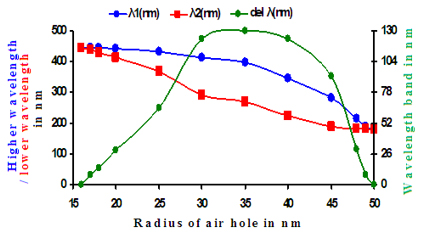 and 3b
and 3b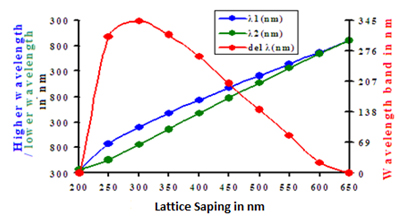 ) respectively.
) respectively.
 |
Fig. (3a) Variation of higher wavelength, lower wavelength and wavelength width/band with radius of air holes, when lattice spacing of the structure is taken of 100 nm. |
Fig. (3a ) represents the variation of higher wavelength (λ1), lower wavelength (λ2) and wavelength width/band (Δλ) with respect to radius of air hole, which varies from 16 nm to 50 nm, when lattice spacing is 100 nm. Similarly, Fig. (3b
) represents the variation of higher wavelength (λ1), lower wavelength (λ2) and wavelength width/band (Δλ) with respect to radius of air hole, which varies from 16 nm to 50 nm, when lattice spacing is 100 nm. Similarly, Fig. (3b ) represents the variation of higher wavelength, lower wavelength and wavelength width/band with respect to lattice spacing of structure, which varies from 200 nm to 650 nm, when radius of air holes is 100 nm. From Fig. (3a
) represents the variation of higher wavelength, lower wavelength and wavelength width/band with respect to lattice spacing of structure, which varies from 200 nm to 650 nm, when radius of air holes is 100 nm. From Fig. (3a ), it is seen that higher wavelength and lower wavelength are taken along primary y-axis, where wavelength width is taken along secondary y-axis with respect to radius of air hole along primary x-axis. Similarly from Fig. (3b
), it is seen that higher wavelength and lower wavelength are taken along primary y-axis, where wavelength width is taken along secondary y-axis with respect to radius of air hole along primary x-axis. Similarly from Fig. (3b ), it is seen that higher wavelength and lower wavelength are taken along primary y-axis, where wavelength width is taken along secondary y-axis with respect to radius of air hole along primary x-axis. From Fig. (3a
), it is seen that higher wavelength and lower wavelength are taken along primary y-axis, where wavelength width is taken along secondary y-axis with respect to radius of air hole along primary x-axis. From Fig. (3a ), it is also observed that both higher and lower wavelengths corresponding to radius of air holes gradually decrease for example; both higher and lower wavelength decrease from 446 nm to 180 nm with the increasing of radius of air hole which varies from 16 nm to 50 nm, however an interesting variation of wavelength width (λ1-λ2) is found with respect to the same radius, for example; λ1-λ2 increases from 0 to 130 nm with radius from 16 nm to 35 nm and further decreases to 0. It is also seen that though the wavelength values of higher and lower band are same at radius of 16 nm and 50 nm, the track of variation is different. The same is clearly mentioned in Fig. (3a
), it is also observed that both higher and lower wavelengths corresponding to radius of air holes gradually decrease for example; both higher and lower wavelength decrease from 446 nm to 180 nm with the increasing of radius of air hole which varies from 16 nm to 50 nm, however an interesting variation of wavelength width (λ1-λ2) is found with respect to the same radius, for example; λ1-λ2 increases from 0 to 130 nm with radius from 16 nm to 35 nm and further decreases to 0. It is also seen that though the wavelength values of higher and lower band are same at radius of 16 nm and 50 nm, the track of variation is different. The same is clearly mentioned in Fig. (3a ). Similarly from Fig. (3b
). Similarly from Fig. (3b ), it is also observed that higher and lower wavelengths corresponding to lattice spacing gradually increases for example; both higher and lower wavelength increases from 365 nm to 2910 nm with the increasing of lattice spacing which varies from 200 nm to 650 nm, however an interesting variation of wavelength width (λ1-λ2) is found with respect to same lattice spacing for example ‘λ1-λ2’ increases from 0 to 344 nm with lattice spacing from 200 nm to 300 nm and further decreases to 0. It is also seen that though the wavelength values of higher and lower band are same at lattice spacing of 200 nm and 650 nm, the track of variation is found to be different. The same is clearly mentioned in Fig. (3b
), it is also observed that higher and lower wavelengths corresponding to lattice spacing gradually increases for example; both higher and lower wavelength increases from 365 nm to 2910 nm with the increasing of lattice spacing which varies from 200 nm to 650 nm, however an interesting variation of wavelength width (λ1-λ2) is found with respect to same lattice spacing for example ‘λ1-λ2’ increases from 0 to 344 nm with lattice spacing from 200 nm to 300 nm and further decreases to 0. It is also seen that though the wavelength values of higher and lower band are same at lattice spacing of 200 nm and 650 nm, the track of variation is found to be different. The same is clearly mentioned in Fig. (3b ).
).
CONCLUSION
Realization of optical mirror using 2D triangular photonic crystal structure is thoroughly discussed in this paper. Photonic band gap of photonic crystal structure play an important role in discussing mirror application. Photonic band depends on both lattice spacing and configuration of same structure. Finally, it is observed that variation of reflected wavelength band depends on both radius of air holes and lattice spacing of crystal structure.
 |
Fig. (3b) Variation of higher wavelength, lower wavelength and wavelength width/band with lattice spacing of structure, when radius of air holes is taken of 100 nm. |
CONFLICT OF INTEREST
The authors confirm that this article content has no conflict of interest.
ACKNOWLEDGEMENTS
Declared none.
REFERENCES
| [1] | J. Joannopoulos, S.G. Johnson, J. Winn, and R.D. Meade, Photonic Crystals: Molding the Flow of Light., University Press: Princeton, 1995. |
| [2] | G. Palai, "Measurement of impurity concentration in chalcogenide glasses using optical principle", Optik-International Journal for Light and Electron Optics, vol. 125, no. 19, pp. 5794-5799, 2014. [http://dx.doi.org/10.1016/j.ijleo.2014.07.004] |
| [3] | Q. Gong, and X. Hu, Photonic Crystals: Principles and Applications., 1st ed Pan Stanford CRC Press, 2014. |
| [4] | G. Palai, and S.K. Tripathy, "A novel method for measurement of concentration using two dimensional photonic crystal structures", Optics Communications, vol. 285, no. 10–11, pp. 2765-2768, 2012. [http://dx.doi.org/10.1016/j.optcom.2012.01.072] |
| [5] | G Palai, SK Tripathy, and T Sahu, "A novel technique to measure the sucrose concentration in hydrogel sucrose solution using two dimensional photonic crystal structures", Optik – International Journal for Light and Electron Optics , vol. 125, no. 01, pp. 349-352, 2014. [http://dx.doi.org/10.1016/j.ijleo.2013.06.057] |
| [6] | G Palai, and SK Tripathy, "Measurement of glycerol concentration in B–H–G solution using 3D photonic crystal structure", Optik – International Journal for Light and Electron Optics , vol. 125, no. 09, pp. 2875-2879, 2014. [http://dx.doi.org/10.1016/j.ijleo.2013.11.055] |
| [7] | G. Palai, S.K. Tripathy, N. Muduli, S.K. Patnaik, and D. Patnaik, "A novel method to measure the strength of CygelTM by using two dimensional photonic crystal structures", AIP Conference Proceedings, vol. 1461, pp. 383-386, 2012. [http://dx.doi.org/10.1063/1.4736926] |
| [8] | F. Schubert, Materials-Refractive-index-and-extinction-coefficient, 2004. Available from: http://www.rpi.edu/~schubert/Educational- resources/Materials-Refractiveindex-and-extinction-coefficient.pdf |
| [9] | V. Lousse, W. Suh, O. Kilic, S. Kim, O. Solgaard, and S. Fan, "Angular and polarization properties of a photonic crystal slab mirror", Optics Express, vol. 12, no. 8, pp. 1575-1582, 2004. [http://dx.doi.org/10.1364/OPEX.12.001575] [PMID: 19474983] |
| [10] | L. Ferrier, S. Boutami, and F. Mandorlo, "Vertical microcavities based on photonic crystal mirrors for III-V/Si integrated microlasers", In: Proceedings of Spie - The International Society for Optical Engineering, France, 2008. [http://dx.doi.org/10.1117/12.781328] |
| [11] | S.A. Moore, L. OFaolain, T.P. White, and T.F. Krauss, "Photonic crystal laser with mode selective mirrors", Optics Express, vol. 16, no. 2, pp. 1365-1370, 2008. [http://dx.doi.org/10.1364/OE.16.001365] [PMID: 18542208] |
| [12] | L. Orsila, "Monolithic fiber mirror and photonic crystal technology for high repetition rate all-fiber soliton lasers", IEEE Photonics Technology Letters, vol. 19, no. 24, pp. 2009-2011, 2007. [http://dx.doi.org/10.1109/LPT.2007.909625] |
| [13] | I.A. Sukhoivanov IV, Guryev, ‘Physics and Practical Modeling: Photonic Crystals., Springer: Heidelberg, 2009. [http://dx.doi.org/10.1007/978-3-642-02646-1] |




